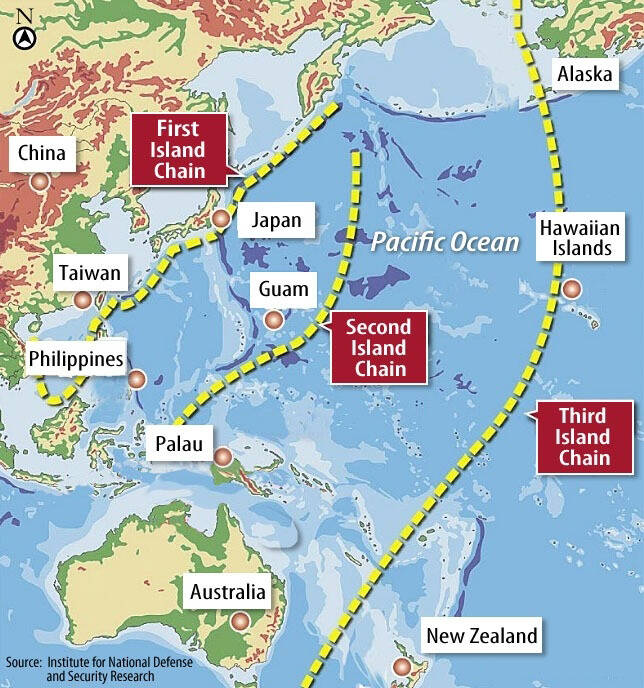The US Marine Corps (USMC) has introduced new anti-drone systems to bolster air defense in the Pacific island chain amid growing Chinese military influence in the region, The Telegraph reported on Sunday.
The new Marine Air Defense Integrated System (MADIS) Mk 1 is being developed to counter “the growing menace of unmanned aerial systems,” it cited the Marine Corps as saying.
China has constructed a powerful defense mechanism in the Pacific Ocean west of the first island chain by deploying weapons such as rockets, submarines and anti-ship missiles — which is part of its anti-access/area denial (A2/AD) strategy against adversaries — the report said.

It is transforming the swathe of the ocean from Japan to the Philippines into a dangerous “no man’s land” that could deter the US and allied forces from entering, while Chinese forces would have greater freedom of movement, it said.
To counteract Beijing’s A2/AD deployment along the first island chain, the Marine Corps is establishing new littoral regiments, which would execute “island hopping” strategies to counter Chinese warships with mobile anti-ship missiles, the report said.
MADIS would be mounted on two Joint Light Tactical Vehicles.
One vehicle would be equipped with a machine gun, a 30mm autocannon and a launcher for Stinger infrared-guided anti-aircraft missiles ranging up to 8km, the report said.
The other vehicle would carry a radar and command suite that detects targets and directs an engagement, it said.
MADIS is a key component of the Marine Corps’ modernization strategy and is compatible with new equipment, such as General Atomics’ MQ-9 surveillance drones, mobile surveillance radars and robotic launchers for Naval Strike Missile anti-ship missiles, the report said.
The Marine Corps in 2020 was reorganized to facilitate its modernization, including retiring traditional heavy weapons such as main battle tanks and building three littoral 2,000-person regiments, it said.
Although the reform at first encountered internal resistance, it has borne fruit and become exemplary for the US’ Pacific allies, the report added.
The 3rd Marine Littoral Regiment’s MADIS fired at target drones in the training exercises performed in Hawaii on Jan. 25, it said.
MADIS markedly enhanced littoral regiments’ tactical flexibility by enabling them to detect and defend the airspace without relying on other branches of the armed forces, the report cited the marine corps as saying.
Such self-reliance is critical, as the regiments could be divided into battalions or companies and must operate alone at their island outposts even when surrounded by enemies, it said.
Therefore, the Marine Corps’ strategy emphasizes the importance of emissions control, or radio silence, while the littoral troops are deployed, the report said.
Ideally, Chinese naval forces would enter a MADIS’ missile range without noticing the Marine Corps’ deployment, but still the littoral troops must be capable of independent operations at their isolated outposts, it said.
They cannot expect the US Navy or US Air Force to riskily enter China’s A2/AD zone to rescue them if Chinese drones come snooping, the report said.
MADIS is considered a “last-ditch defense,” but frontline Marine Corps troops might have to employ it more often than expected, as threats from Chinese forces are rising in the West Pacific, it said.

South Korean K-pop girl group Blackpink are to make Kaohsiung the first stop on their Asia tour when they perform at Kaohsiung National Stadium on Oct. 18 and 19, the event organizer said yesterday. The upcoming performances will also make Blackpink the first girl group ever to perform twice at the stadium. It will be the group’s third visit to Taiwan to stage a concert. The last time Blackpink held a concert in the city was in March 2023. Their first concert in Taiwan was on March 3, 2019, at NTSU Arena (Linkou Arena). The group’s 2022-2023 “Born Pink” tour set a

CPBL players, cheerleaders and officials pose at a news conference in Taipei yesterday announcing the upcoming All-Star Game. This year’s CPBL All-Star Weekend is to be held at the Taipei Dome on July 19 and 20.

The Taiwan High Court yesterday upheld a lower court’s decision that ruled in favor of former president Tsai Ing-wen (蔡英文) regarding the legitimacy of her doctoral degree. The issue surrounding Tsai’s academic credentials was raised by former political talk show host Dennis Peng (彭文正) in a Facebook post in June 2019, when Tsai was seeking re-election. Peng has repeatedly accused Tsai of never completing her doctoral dissertation to get a doctoral degree in law from the London School of Economics and Political Science (LSE) in 1984. He subsequently filed a declaratory action charging that

The Hualien Branch of the High Court today sentenced the main suspect in the 2021 fatal derailment of the Taroko Express to 12 years and six months in jail in the second trial of the suspect for his role in Taiwan’s deadliest train crash. Lee Yi-hsiang (李義祥), the driver of a crane truck that fell onto the tracks and which the the Taiwan Railways Administration's (TRA) train crashed into in an accident that killed 49 people and injured 200, was sentenced to seven years and 10 months in the first trial by the Hualien District Court in 2022. Hoa Van Hao, a